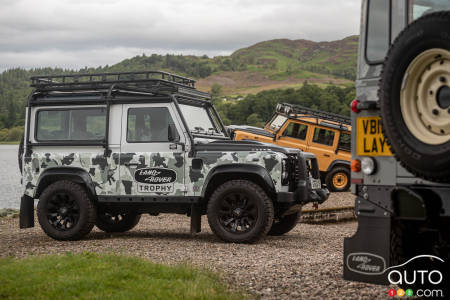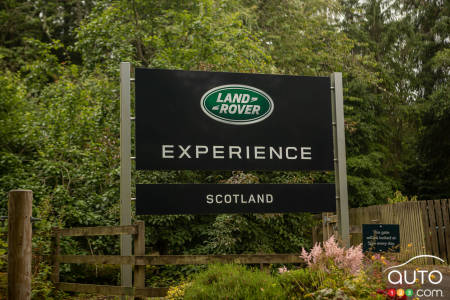• Auto123 took part in 2024 in a unique Land Rover Rover Defender Experience. Here’s what that was like.
Dunkeld, Scotland - I’m feeling every bump and berm as I traverse the green pastures and idyllic tree-line roads. The V8 in front of me is working hard – you can tell, because there isn’t much sound deadening in here – and the steering wheel is writhing in my hands as it does battle with the log of a front axle that’s in turn battle with the ruts below.
At least the view out is good. I’m sitting straight up, and thankfully the square hood stretching away through the upright windscreen helps me with driving on the left side of the road.
The setting is Scotland, and the car is a Land Rover Defender 110, though not one of the newfangled turbocharged versions. This is what you might call an “OG” Land Rover, an example of the vehicles that have tilled fields, hauled hay bales, gotten kids to school and climbed mountains for decades.

A brand with a history
There are few brands more storied than Land Rover. Things started with the Defender Series I, an offroad-military-farmer’s best friend type of vehicle that has morphed into a preeminent luxury SUV brand. Indeed, given Land Rover’s popularity within a beleaguered Jaguar-Land Rover conglomerate, these vehicles are not just legendary, they’re now a lifeline for the company.
The Land Rover Experience
It's with that history in mind that we set off to Scotland to drive the original Land Rover, the big daddy pioneer that started the show for the brand: the Defender. The opportunity came via the Land Rover Experience, a program that features a number of different modules across the world to help new owners get better acquainted with their vehicles and of course to introduce new folks to the brand.
There’s even a “young off-roader experience” program that puts young drivers and their parents in a Defender they then take off the beaten path, while being instructed by the on-hand expert Land Rover off-roaders.

The best part? Well, in addition to the fact that the very cool Defender off-roaders are provided as part of the $359 charge, there’s no experience required so anyone can get in and drive.
There are also sessions teaching advanced off-road techniques and winching, and recovery programs that delve into the nitty-gritty of off-roading.
While we didn’t experience those on this particular event in Scotland, we did attend a protracted version of the event at the Biltmore Estate in Asheville, NC last year. There, we piloted Defender 130 Outbound edition vehicles over a range of off-road obstacles including steep climbs over loose terrain, off-camber “elephant tracks” that are basically moguls for off-roaders and slippery, muddy traverses.
As you’d guess, the vehicles had no trouble conquering all this – even in their biggest, longest-wheelbase form. But the bigger takeaway was the instruction we received. The instructors would ride with us and keep a watchful eye on our inputs, informing us when we may be applying too much throttle (or not enough), when we should be changing off-road modes and even reminders of how to properly grip the wheel – keep your thumbs on the rim as opposed to wrapped around the rim for fear of injury should the wheel get wrenched in your hands by an unseen boulder.
Old yet new
Full disclosure: the models we drove, while looking classic, aren’t, really. They are all modified versions of the last years of the original Defender platform, before the current one arrived in 2020. That version of the Defender ran all the way until 2016 so the materials seen here, the gauges and other details feel somewhat modern.
There’s plenty of the classic here as well, though. The centre console, for example a button array like you don’t see anymore, especially in modern Land Rovers and Range Rovers which all use digital displays. Here our vehicles had classic dials for the fan controls, a comprehensive bank of rectangular buttons strung across the top for the lights and defrost and a radio that looks a lot like the aftermarket unit I had in my old Honda Civic – which was from 1992.
Even the window switches are there – just like in a current Jeep Wrangler and where did you think Jeep got that idea from? Those are notable less so because of their placement, and more so because the fact that there are power windows at all seems almost anachronistic.
You do see things that have made their way to current Defenders, for instance the hand-holds everywhere, the gear lever jutting out from the base of the centre console, and the upright orientation of the dash and cabin.
By the way: eagle-eyed Defender-philes will notice that the gear lever is a direct lift from the current vehicle. As mentioned, these are specialty Defenders that may look like the old model. They actually have an engine and gearbox from the current model.
Not that that old Defender vibe isn’t very present. The driver seating position is upright, the steering wheel angle is weird and legroom is, well, let’s just say “at a premium”. The cargo area is also smallish, especially in the two-door model we sampled, especially since this particular version has seats there. They can be folded to provide more space but the way they flip up and against the walls of cargo area means that the available space is not quite what it seems.
Of course, there particular Land Rovers aren’t so much about practicality, though. They’re unique takes on the platform and they’re more about the “wow” factor. That two-door 90 version even has specialized racing seats. Another 90 version there had a wooden cargo floor.
Then there was my personal favourite: a four-door 110 model styled to recall the Land Rover Trophy racers of old. It has a roof rack that wouldn’t look out of place on a safari vehicle, a set of spotlights that wouldn’t look out of place on a rally car and a bull bar that wouldn’t look out of place on an Australian road train rig. Add the yellow paintjob and matching “steelie” wheels and what do you get? Peak Defender.
Often times when I test a vehicle – and there have been many – I can usually say that once you get in and start to drive, a lot of that surface stuff tends to melt away. As the focus shifts from the ease of which you can pair an iPhone to the ease with which you can cut a perfect line through a bend or make a pass at highway speeds, the rest is background.
Not here, though. Not in a “Landie”.
Tractor-like?
Even with the newfangled powertrain, the blocky tires and live axle suspension make for a ride that is about as tractor-like as you’re going to get from a modern road vehicle these days. As we drove over rutted dirt roads topped with loose gravel, it felt as if these trucks could mash, crash and bang their way through pretty much anything if you wanted them to. And as if, with its two-speed transfer case and locking differentials, it could climb, descend and traverse over any type of terrain.
For someone who had never before experienced a made-to-order off-roader, it was a real watershed moment. Yes, the seating position is awkward, the ride is bouncy and while there’s plenty of power from the V8 underhood, the chassis and steering isn’t really tuned for performance driving. And as speeds increase, it does start to feel a little wallowy (the original 50s and 60s versions of these could barely crack the 50 mph barrier), then quite wallowy as you push some more.
But there is an indelible feeling, at the helm of a Defender, that you’re piloting something mechanical, that you’re in control, that there aren’t a slew of electronic nannies keeping you in your lane or telling you there’s a motorcycle in your blind spot or not allowing you to get to close to the car ahead of you and so on.
There’s noting inherently wrong with those modern features, but there’s something inherently right about driving with no electronic strings attached. The Defender is going to do what it’s always done: dig deep, give ‘er hell and pull that stubborn stump out of the ground – and you can’t compete with that!





